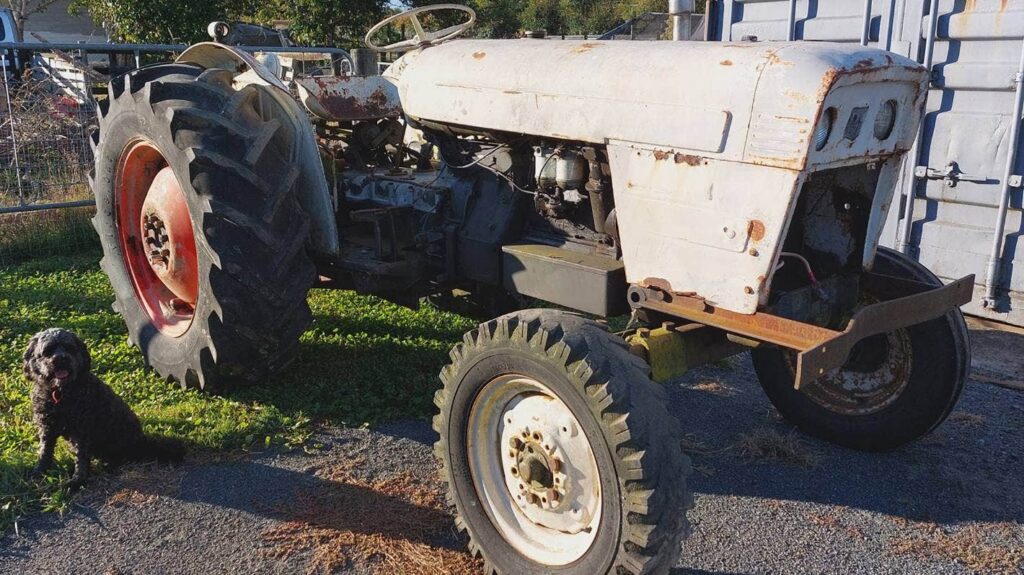Converting a diesel tractor into an electric one sounds like no easy feat, but for one Waikato-based tinkerer it was an exciting prospect and one he had accomplished before – albeit on a smaller scale.
Dougal Mair, who works as a networks and cyber security teams manager at Waikato University, previously converted a moped into an e-scooter to reduce his carbon footprint commuting to work.
“We live close enough to my work at the University of Waikato that I always thought I shouldn’t really be using a car every day to go to and from work, so I thought about an electric bike. That gave me the idea for an electric scooter,” he says.
Rather than buying one, he put his radio, electronics and computer engineering skills to work and converted an old retro petrol scooter into an e-bike using technology that was in his “wheelhouse”.
After successfully building his eco-friendly ride to work, Mair was ready for his next project. He considered building an electric car, but the regulatory requirements seemed too onerous, so he settled on converting a tractor to use on his lifestyle block, and set about doing the necessary work to get the ball rolling.
Mair started researching the tractor project around mid-2021 and decided it was doable before setting out to find the perfect tractor for his new project.
“At the time I saw that Mike Casey [a Cromwell-based orchardist who had recently imported the electric orchard tractor from the United States] had converted a small Iseki tractor, and a couple of others had done Fergie tractors overseas … I settled on a David Brown.”

Mair says apart from the David Brown being similar in size and power to the Fergie 135 he was using at the time, it was reasonably priced and also served the project’s purpose well.
“The older David Browns have a full frame connecting the front and back, but I also worked out that the David Brown 880’s engine sump frame could be left in place with the engine removed too.”
Fast-forward to February 2022, and Mair found a suitable DB880 “a guy had sitting behind a shed” and went to work with the help of his father-in-law Jack Brinkman, a retired design engineer.
“The first thing was to get rid of the diesel engine and see what I was left with,” Mair says.
He sourced parts for the build from China, either direct from the manufacturer or via AliExpress.
“One of the motors and controllers and the battery pack I sourced from NZ suppliers. Basically I was in no hurry to get the project completed, so I tried to source most parts via the most cost-effective way.”
The tractor, which is now functional but still a “work in progress”, has cost Mair just shy of $25,000 to get up and running.
“I actually spent a bit more than $20,000 for this project ($24.5k including tractor cost of $2600), as I bought six Deep Cycle 12V batteries and cables for testing and I bought an extra motor controller that I didn’t need when I increased the voltage from 48V to 72V.
“Someone doing the same conversion following my design and with similar electrical components would easily stay within $20k – cheaper if they already have an old tractor to convert and they watch the exchange rate. I bought stuff while the New Zealand-US dollar exchange rate was below 0.6, which wasn’t flash.”
In September 2022 the newly converted e-tractor stretched its legs for the first time. So far 58-year-old Mair, who was raised on a dairy farm, has been using the e-tractor for small jobs on his 4ha block, which he uses to graze horses for his wife, who rides dressage, plus the cattle they have “to eat the grass the fussy horses won’t”.
“I won’t be using the tractor all that often. On average, a couple of times a month – more in summer and less in winter.”
In hindsight, while there aren’t many things he would do differently, Mair admits it was a challenge even for him at times, but not “beyond my practical skills”.
He also wouldn’t be keen to do a similar project for someone else because “these projects wouldn’t be cheap if you are paying someone for their time”, but he is open to consulting.
“I think most people who know a bit about tractors and general engineering would be okay with the mechanical engineering bits, but some knowledge of electrical/electronics is also required.”
Beyond the technical know-how, he says that embarking on a project such as this requires a lot of safety precautions as well.
“A lot of care is required, as you’re dealing with large amounts of power (low voltage, but high amps). Making a mistake and shorting something will melt your screwdrivers and spanners, and could also easily start a fire. Frying some of your expensive electric components is always a concern too.”
Mair also documented the entire project on his blog, along with photos and videos on the work he’s done during the conversion process.
As for other projects in the pipeline, Mair says for now he’s focused on doing the final tweaks to the e-tractor, including getting a matching three-rib front tyre, but does have “a related side project on the boil”.
More: To check out Mair’s e-tractor and previous projects, visit his blog here.










